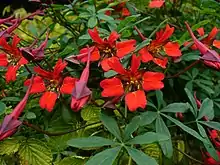Tropaeolum speciosum
Tropaeolum speciosum, the flame flower or flame nasturtium,[1] is a species of flowering plant in the family Tropaeolaceae native to Chile, where it is known locally as coralito, quintralito, or voqui.[2]
| Tropaeolum speciosum | |
|---|---|
 | |
| Scientific classification | |
| Kingdom: | Plantae |
| Clade: | Tracheophytes |
| Clade: | Angiosperms |
| Clade: | Eudicots |
| Clade: | Rosids |
| Order: | Brassicales |
| Family: | Tropaeolaceae |
| Genus: | Tropaeolum |
| Species: | T. speciosum |
| Binomial name | |
| Tropaeolum speciosum Poepp. & Endl. | |
Description
It is a hardy herbaceous tuberous perennial with a wiry stem that grows up to 3 metres (9.8 ft) tall. It climbs through or over other plants to a sunlit position where it flowers profusely. The leaves are palmately lobed with five to seven obovate leaflets. The scarlet, funnel-shaped flowers are spurred and grow on long stalks from the leaf axils. They have widely separated, clawed petals. After the flowers fade, the red calyces persist, curling back to reveal the three blue berries.[2]
Cultivation
The flame flower is not considered easy to grow. In some places it thrives and in others it fails completely. It does particularly well in New Zealand and Scotland. It has been called the "Scottish flame flower" and the "glory of the Highlands". It will grow in full sun or partial sun but likes a cool moist root run and is suited to acid or neutral soils. It can be propagated from seed or by division.[3] The plant cannot tolerate lengthy periods of snow cover but is hardy down to a temperature of about −12 °C (10 °F). It is in USDA Hardiness Zone 8. It must be considered as such because during dormancy it generally retreats to a small underground tuber, where frost often does not penetrate.
This plant has gained the Royal Horticultural Society's Award of Garden Merit.[4][5]
Status
In 2020, T. Speciosum was listed on the New Zealand National Pest Plant Accord.[6] As such, it is illegal to breed, distribute, release or sell the plant within that country.
References
- "Tropaeolum speciosum". Germplasm Resources Information Network. Agricultural Research Service, United States Department of Agriculture. Retrieved 2018-01-21.
- Michail Belov (2005–2009). "Tropaeolum speciosum ". FloraChile. Retrieved 2012-06-22.
- Perry, Frances (1972). Flowers of the World. The Hamlyn Publishing Group Ltd. p. 299. ISBN 0600355926.
- "RHS Plant Selector - Tropaeolum speciosum". Retrieved 5 March 2021.
- "AGM Plants - Ornamental" (PDF). Royal Horticultural Society. July 2017. p. 103. Retrieved 26 December 2018.
- "New Zealand Plant Conservation Network - Tropaeolum speciosum". Retrieved 29 September 2023.